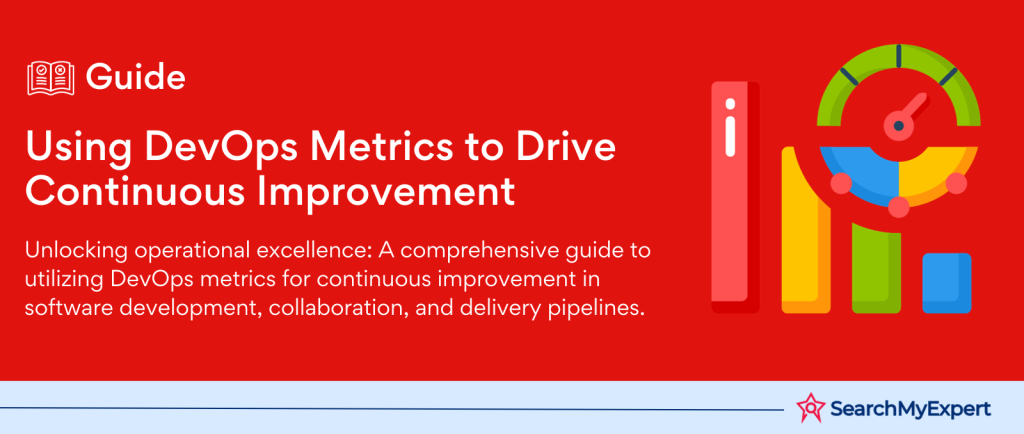DevOps Performance Metrics: Improving Software Development Practices
In the fast-paced world of software development, DevOps has emerged as a game-changer. It’s not just a buzzword; it’s a methodology that brings together development and operations teams to streamline the software delivery process. In this article, we’ll delve into the core principles of DevOps, explore the role of performance metrics in this paradigm, and underline the significance of measuring performance for continuous improvement.
What is DevOps?
DevOps is a portmanteau of “Development” and “Operations,” and it represents a cultural and technical shift in how software development and IT operations collaborate. It’s a set of practices, principles, and tools aimed at automating and integrating the processes of software development and IT operations teams. The primary goal of DevOps is to shorten the software development lifecycle, increase the frequency of software releases, and improve the quality of software products.
Core Principles of DevOps
DevOps is guided by several core principles:
- Collaboration:
DevOps promotes collaboration and communication between development and operations teams. This ensures that everyone is on the same page and works towards common goals. - Automation: Automation of repetitive tasks, such as code integration, testing, and deployment, is a cornerstone of DevOps. Automation reduces human error and accelerates the development process.
- Continuous Integration (CI): Developers integrate their code into a shared repository frequently, often multiple times a day. This practice ensures that code changes are tested and verified as soon as possible.
- Continuous Delivery (CD):
CD extends CI by automatically deploying code changes to production or staging environments after passing automated tests. It allows for rapid and reliable software releases. - Monitoring and Feedback:
DevOps teams constantly monitor application performance and collect feedback. This data is used to identify and address issues promptly.
The Role of Performance Metrics in DevOps
Performance metrics play a pivotal role in the DevOps ecosystem. They provide valuable insights into the health and efficiency of the software development and deployment pipeline. Let’s explore their significance:
Real-time Monitoring
Performance metrics enable real-time monitoring of applications and infrastructure. DevOps teams can track key indicators such as response times, error rates, and resource utilization. When deviations from normal behavior occur, alarms can be triggered, allowing teams to respond proactively to issues.
Root Cause Analysis
When problems arise, performance metrics serve as a crucial tool for root cause analysis. DevOps professionals can pinpoint the exact stage of the development or deployment process where issues occurred. This helps in rapid troubleshooting and resolution.
Capacity Planning
Performance metrics aid in capacity planning by providing data on resource consumption trends. DevOps teams can anticipate when additional resources are needed to support growing workloads, preventing performance bottlenecks.
Continuous Improvement
DevOps is all about continuous improvement, and performance metrics provide the foundation for it. By analyzing historical data, teams can identify areas for enhancement in the development pipeline. This leads to iterative refinements and optimizations.
The Importance of Measuring Performance
Why is measuring performance so crucial in DevOps? Here are some compelling reasons:
Data-Driven Decision Making
Performance metrics offer an objective basis for decision-making. Instead of relying on gut feelings or intuition, DevOps teams can make informed choices backed by data. This minimizes risks and enhances the chances of successful software delivery.
Early Issue Detection
Performance metrics enable the early detection of issues. By catching problems in their infancy, teams can address them before they escalate into major disruptions or outages. This proactive approach saves time, money, and reputation.
Continuous Learning
Measuring performance fosters a culture of continuous learning. DevOps teams can experiment with new approaches and technologies, measure their impact, and iterate accordingly. This cycle of learning and adaptation leads to innovation and competitiveness.
Customer Satisfaction
Ultimately, the end goal of DevOps is to deliver high-quality software that meets customer expectations. Performance metrics help ensure that applications perform optimally, leading to a positive user experience and customer satisfaction.
Key Performance Indicators (KPIs) in DevOps: Measuring Success
In the world of DevOps, the ability to measure success and identify areas for improvement is paramount. This is where Key Performance Indicators (KPIs) come into play. In this step, we will introduce the concept of KPIs in the context of DevOps, categorize them into different areas, and provide examples of specific KPIs for each category.
Understanding KPIs in DevOps
Key Performance Indicators (KPIs) are quantifiable metrics that organizations use to evaluate their performance and progress towards specific goals. In the DevOps context, KPIs serve as vital tools for tracking and assessing various aspects of the software development and deployment process. They provide actionable insights into how well a DevOps initiative is functioning and where improvements can be made.
Categories of DevOps KPIs
DevOps KPIs can be categorized into several areas, each offering a unique perspective on the development and delivery process. Let’s explore these categories and provide examples of KPIs for each one:
Delivery KPIs
Delivery KPIs focus on the speed and efficiency of delivering new features, updates, and enhancements to end-users.
- Lead Time: The time it takes to move from code commit to production deployment. Shorter lead times indicate faster feature delivery.
- Deployment Frequency: The frequency at which new code changes are deployed to production. High deployment frequency reflects agility and responsiveness.
- Change Failure Rate:
The percentage of changes or deployments that result in failures or incidents. A low change failure rate indicates robust testing and deployment processes.
Operation KPIs
Operation KPIs center around the reliability and stability of the software in production environments.
- Incident Resolution Time:
The average time it takes to resolve incidents or outages in production. Quick incident resolution minimizes downtime. - Mean Time Between Failures (MTBF):
The average time between system failures. A longer MTBF suggests improved system reliability. - Availability:
The percentage of time that a system or service is operational and accessible to users. High availability is essential for customer satisfaction.
Collaboration KPIs
Collaboration KPIs measure the effectiveness of communication and teamwork between development and operations teams.
- Deployment Lead Time:
The time it takes for a code change to move from development to production, including all necessary approvals. Streamlined lead times indicate efficient collaboration. - Feedback Loop Time: The time it takes to collect feedback from users or stakeholders and incorporate it into the development process. Short feedback loop times foster responsiveness to user needs.
- Cross-Functional Team Engagement: The level of engagement and cooperation between development and operations team members. High engagement promotes a culture of collaboration.
Examples of Specific DevOps KPIs
Let’s delve deeper into specific examples of KPIs within each category:
Delivery KPIs:
- Lead Time:
Achieving a lead time of less than 24 hours for code changes. - Deployment Frequency: Releasing code changes to production at least once a day.
- Change Failure Rate: Maintaining a change failure rate below 5% for the past three months.
Operation KPIs:
- Incident Resolution Time:
Resolving critical incidents within an average of 30 minutes. - Mean Time Between Failures (MTBF):
Increasing MTBF to 90 days or more. - Availability:
Ensuring system availability of 99.9% or higher.
Collaboration KPIs:
- Deployment Lead Time:
Reducing deployment lead time by 20% through improved collaboration. - Feedback Loop Time: Shortening the feedback loop time from users to development teams to less than 24 hours.
- Cross-Functional Team Engagement:
Achieving a score of 90% or higher in team engagement surveys.
Measuring Delivery Performance in DevOps: Speed, Agility, and Automation
In the world of DevOps, delivery performance is a critical aspect that directly impacts the efficiency and competitiveness of software development teams. In this step, we will dive deep into metrics related to software delivery speed and agility. We’ll discuss key performance indicators (KPIs) such as lead time, deployment frequency, and cycle time, and analyze how automation and continuous integration/continuous delivery (CI/CD) practices impact these metrics.
Understanding Delivery Performance Metrics
Delivery performance metrics provide insights into how quickly and efficiently software changes are delivered to production or other target environments. They gauge the ability of DevOps teams to respond to user needs, adapt to market demands, and maintain a competitive edge.
Lead Time
Lead time measures the time it takes for a code change to move from the initial idea or request to production deployment. It includes all the stages of the development and delivery pipeline, from code writing to testing and deployment. Shortening lead time is a core objective in DevOps, as it allows for faster feature delivery and quicker response to market changes.
Deployment Frequency
Deployment frequency reflects how often code changes are deployed to production or staging environments. High deployment frequency is a hallmark of agile DevOps practices and enables teams to release new features and improvements rapidly. It reduces the time to market and enhances the ability to address customer needs promptly.
Cycle Time
Cycle time measures the time it takes to complete a single cycle of development, from the inception of an idea or feature request to its delivery to users. It is closely related to lead time but focuses on the duration of a single development cycle rather than the entire pipeline. Reducing cycle time enhances agility and responsiveness.
Impact of Automation and CI/CD on Delivery Performance
Automation and CI/CD practices are instrumental in improving delivery performance metrics. Here’s how they impact these key indicators:
Automation:
- Faster Testing:
Automated testing reduces the time required for quality assurance. Regression tests, unit tests, and integration tests can be executed rapidly, leading to shorter lead times and faster cycle times. - Consistency:
Automation ensures consistent and repeatable processes throughout the development pipeline. This reduces the likelihood of errors and failures, improving deployment frequency and reliability. - Resource Optimization: Automated provisioning of infrastructure and resources allows for on-demand scaling. This ensures that resources are available when needed, enhancing deployment frequency and reducing lead times.
Continuous Integration/Continuous Delivery (CI/CD):
- Streamlined Pipelines:
CI/CD pipelines automate the building, testing, and deployment of code changes. This streamlines the development process, reducing lead times and cycle times. - Quick Feedback:
CI/CD provides rapid feedback on code changes. Developers receive immediate notifications of build and test failures, allowing for quick resolution and minimizing disruptions to deployment frequency. - Rollback and Rollforward:
CI/CD pipelines include mechanisms for rollbacks and rollforwards. This means that if a deployment fails, it can be rolled back to a previous version, or a fix can be deployed quickly, minimizing downtime and reducing the impact on deployment frequency.
Monitoring Operational Performance in DevOps: Ensuring Reliability and Stability
Operational performance in DevOps is a critical aspect that directly impacts the stability and reliability of deployed systems. In this step, we will shift our focus to metrics that assess the health and performance of production environments. We’ll explore key performance indicators (KPIs) such as mean time to repair (MTTR), mean time between failures (MTBF), and error rates. Additionally, we’ll explain how infrastructure monitoring and observability tools contribute to the measurement of operational performance.
Key Operational Performance Metrics
Mean Time to Repair (MTTR)
MTTR measures the average time it takes to resolve incidents or outages in production. This metric is crucial for minimizing downtime and ensuring that issues are addressed promptly. A lower MTTR indicates a more efficient incident response process.
Mean Time Between Failures (MTBF)
MTBF represents the average time between system failures or incidents. It is a measure of system reliability, with a longer MTBF indicating a more stable and robust environment. A high MTBF is a desirable goal for DevOps teams.
Error Rates
Error rates quantify the frequency of errors, faults, or anomalies occurring in production systems. These errors can range from application crashes to infrastructure failures. Monitoring error rates helps identify potential issues before they lead to significant incidents.
The Role of Monitoring and Observability Tools
To measure and improve operational performance, DevOps teams rely on monitoring and observability tools. These tools provide real-time insights into the behavior of applications and infrastructure. Here’s how they contribute to the measurement of operational performance:
Infrastructure Monitoring
- Resource Utilization:
Infrastructure monitoring tools track the utilization of resources such as CPU, memory, disk space, and network bandwidth. DevOps teams use this data to ensure that resources are allocated efficiently and that performance bottlenecks are detected early. - Incident Detection: Infrastructure monitoring tools can set up alerts and notifications for predefined thresholds. When resource utilization exceeds normal levels or specific conditions are met, alerts are triggered, allowing teams to investigate and address issues promptly.
- Historical Analysis: These tools collect historical data on resource utilization and performance metrics. DevOps teams analyze this data to identify trends, predict resource needs, and optimize infrastructure for reliability and cost-effectiveness.
Observability Tools
- Distributed Tracing: Observability tools provide distributed tracing capabilities, allowing DevOps teams to track requests as they traverse microservices and various components. This helps in identifying bottlenecks and understanding the flow of requests through the system.
- Log Analysis:
Log data provides detailed insights into application behavior. Observability tools collect and analyze logs, making it easier to pinpoint the root causes of incidents and troubleshoot issues effectively. - Metrics and Dashboards: Observability platforms offer customizable dashboards with real-time metrics and visualizations. These dashboards provide a holistic view of system performance, error rates, and other key indicators, aiding in quick decision-making.
Evaluating Collaboration and Communication in DevOps: Keys to Success
In the dynamic world of DevOps, effective collaboration and communication between development and operations teams are the cornerstones of success. In this step, we will emphasize the significance of collaboration and communication in DevOps and introduce metrics that assess these critical aspects. We’ll explore metrics such as defect escape rate, code review time, and incident response collaboration score. Additionally, we’ll discuss how effective communication tools and practices can improve these collaboration metrics.
The Importance of Collaboration and Communication
Collaboration and communication lie at the heart of DevOps principles. They bridge the gap between development and operations, fostering a culture of teamwork and shared responsibility. Successful DevOps teams prioritize collaboration for several reasons:
- Reduced Silos: Collaboration breaks down organizational silos and promotes cross-functional teamwork. When teams collaborate effectively, they can collectively tackle complex challenges.
- Shared Responsibility: In a DevOps environment, everyone shares responsibility for the entire software delivery process. Effective communication ensures that teams work together seamlessly, from code development to deployment and beyond.
- Continuous Feedback:
Communication channels facilitate continuous feedback, enabling teams to learn from each other’s experiences and iterate on processes and practices.
Key Collaboration Metrics
Defect Escape Rate
Defect escape rate measures the percentage of defects or issues that escape detection during development and testing and are discovered in production. A high defect escape rate indicates a breakdown in collaboration, as critical issues are not caught early in the development process.
Code Review Time
Code review time measures the duration it takes for code changes to undergo peer review. Lengthy code review times can indicate bottlenecks and hinder the rapid delivery of software changes.
Incident Response Collaboration Score
The incident response collaboration score assesses how effectively development and operations teams collaborate during incident resolution. This score considers factors such as response time, communication clarity, and teamwork. A high collaboration score indicates effective incident management.
Improving Collaboration Metrics with Communication Tools and Practices
Effective communication tools and practices play a pivotal role in improving collaboration metrics in DevOps. Here’s how they contribute to success:
- Real-time Chat:
Tools like Slack or Microsoft Teams facilitate real-time chat and messaging. They allow teams to quickly share updates, resolve issues, and maintain constant communication, improving collaboration and incident response. - Collaborative Code Review Tools:
Platforms like GitHub, GitLab, or Bitbucket provide collaborative code review features. They streamline the code review process, reduce review times, and enhance code quality. - Incident Management Platforms:
Dedicated incident management tools like PagerDuty or OpsGenie enable teams to coordinate and respond effectively during incidents. They provide clear incident escalation paths and real-time updates to all stakeholders. - Video Conferencing:
Video conferencing tools like Zoom or Microsoft Teams enable face-to-face communication, even in remote or distributed teams. Visual cues enhance understanding and teamwork during critical discussions. - Documentation and Knowledge Sharing:
Establishing a knowledge-sharing culture through wikis, documentation, and internal wikis helps teams disseminate information and best practices, improving collaboration over time.
Tools and Techniques for Measuring DevOps Performance
Measuring DevOps performance is crucial for continuous improvement and achieving success in software development and delivery. In this step, we will introduce popular tools and platforms for collecting and analyzing DevOps metrics. We’ll also discuss different approaches to visualizing and reporting performance data, along with the use of dashboards and scorecards for monitoring key metrics.
Popular Tools for DevOps Metrics
Prometheus
Prometheus is an open-source monitoring and alerting toolkit designed for reliability and scalability. It can collect metrics from various sources, making it a popular choice for monitoring application and infrastructure performance.
Grafana
Grafana is a widely used open-source platform for visualizing and analyzing metrics. It can integrate with various data sources, including Prometheus, and provides customizable dashboards for monitoring and reporting.
ELK Stack (Elasticsearch, Logstash, Kibana)
The ELK Stack is a powerful combination of Elasticsearch, Logstash, and Kibana, primarily used for log analysis. It allows DevOps teams to collect, store, and visualize log data for troubleshooting and performance analysis.
New Relic
New Relic is a comprehensive observability platform that provides real-time monitoring, application performance management (APM), and infrastructure monitoring. It offers a range of tools for measuring and optimizing DevOps performance.
Datadog
Datadog is a cloud-based monitoring and analytics platform that provides end-to-end visibility into application and infrastructure performance. It offers integrations with various services and tools.
Approaches to Visualizing and Reporting Performance Data
Time Series Charts
Time series charts display metric data over time, making it easy to identify trends, patterns, and anomalies. Tools like Grafana and Prometheus are excellent for creating time series visualizations.
Heatmaps
Heatmaps represent data using color gradients, allowing users to quickly spot areas of high or low activity. They are useful for visualizing resource utilization, error rates, and other metrics.
Bar and Pie Charts
Bar and pie charts provide a clear representation of metrics with distinct categories. They are often used to show the distribution of incidents, response times, or other discrete data points.
Top-N Lists
Top-N lists highlight the top-performing or worst-performing elements based on specific metrics. These lists help prioritize issues or areas for improvement.
Geospatial Maps
Geospatial maps visualize metric data on geographic maps, helping teams understand performance variations across different regions or locations.
Dashboards and Scorecards
Dashboards
Dashboards are customizable interfaces that display a collection of visualizations and metrics in a single view. They provide a real-time overview of key performance indicators (KPIs) and facilitate quick decision-making. Tools like Grafana and Kibana allow users to create and customize dashboards to monitor the health of applications and infrastructure.
Scorecards
Scorecards are a form of dashboard that focus on key metrics and KPIs. They provide a condensed view of critical performance indicators, making it easy for teams to assess their progress and areas that require attention.
Continuous Improvement through Metrics in DevOps
In the world of DevOps, the journey towards excellence is an ongoing process driven by the use of performance metrics. In this step, we’ll reinforce the idea of using performance metrics to drive continuous improvement. We’ll explain how to set targets and track progress towards performance goals, and we’ll encourage ongoing analysis and optimization based on data insights.
The Role of Performance Metrics in Continuous Improvement
Performance metrics in DevOps serve as the compass that guides teams towards better outcomes. They provide a clear understanding of where the strengths and weaknesses lie in the development and delivery process. Here’s why metrics are pivotal for continuous improvement:
- Objective Assessment: Metrics offer an objective and quantifiable assessment of various aspects of DevOps performance. They provide data-driven insights that remove subjectivity from decision-making.
- Identification of Bottlenecks:
Metrics help identify bottlenecks, inefficiencies, and areas for improvement. Teams can pinpoint where time and resources are being wasted and take corrective actions. - Targeted Improvements: With the right metrics in place, teams can set specific targets for improvement. These targets serve as milestones for progress and help teams focus their efforts on areas that matter most.
Setting Targets and Tracking Progress
Define Clear Objectives
Start by defining clear objectives for your DevOps processes. What do you aim to achieve? Whether it’s reducing lead time, increasing deployment frequency, or minimizing error rates, having specific goals in mind is essential.
Select Relevant Metrics
Choose metrics that are directly aligned with your objectives. If your goal is to improve incident response time, then metrics like MTTR and incident resolution time are relevant. Make sure the metrics you select are actionable and meaningful.
Establish Baselines
Before making improvements, establish baselines for your chosen metrics. This provides a starting point for measurement and helps you gauge the impact of changes over time.
Set SMART Targets
SMART stands for Specific, Measurable, Achievable, Relevant, and Time-bound. Ensure that your performance targets meet these criteria. For example, “Reduce lead time by 20% in the next three months” is a SMART target.
Implement Changes
Identify and implement changes and practices that align with your improvement targets. Whether it involves process optimization, tool adoption, or skill development, make changes that have a direct impact on the selected metrics.
Track Progress Regularly
Consistently track and monitor your chosen metrics. Compare current performance against baselines and targets. Use visualization tools and dashboards to make the data accessible and actionable.
Ongoing Analysis and Optimization
Continuous improvement is a cyclical process that never truly ends. DevOps teams should engage in ongoing analysis and optimization based on data insights. Here’s how to keep the cycle of improvement going:
- Analyze Data Trends:
Look for trends and patterns in your performance data. Identify recurring issues or areas where performance is consistently strong. - Collect Feedback:
Gather feedback from team members and stakeholders. Their insights can provide valuable information on areas that may need attention. - Iterate and Experiment: Don’t be afraid to iterate and experiment with new approaches and practices. Be open to adopting emerging technologies or methodologies that could lead to improvements.
- Document and Share Best Practices: Document successful practices and share them across the organization. Encourage a culture of knowledge sharing and learning from each other’s experiences.
Conclusion
In DevOps, the use of performance metrics is not just about measurement; it’s about driving continuous improvement. By defining clear objectives, setting targets, and tracking progress, DevOps teams can make meaningful improvements in their processes and practices. Ongoing analysis and optimization ensure that the journey toward excellence is a never-ending one, ultimately leading to higher efficiency, reliability, and customer satisfaction.
Let our DevOps Company guide your DevOps transformation.
Table of Contents
Toggle






